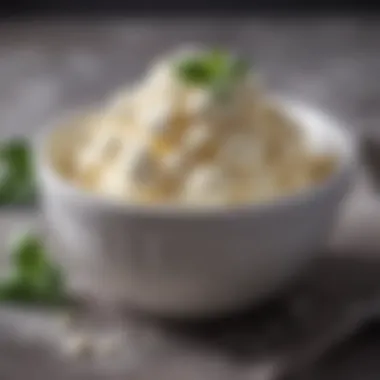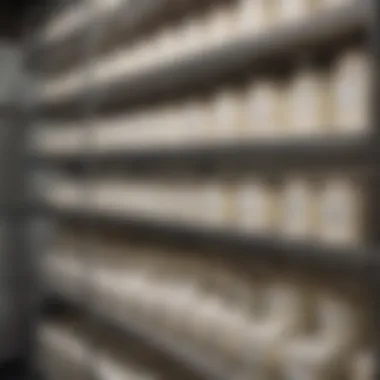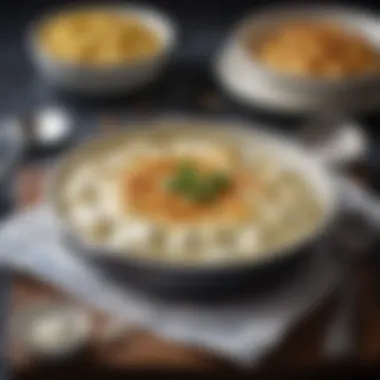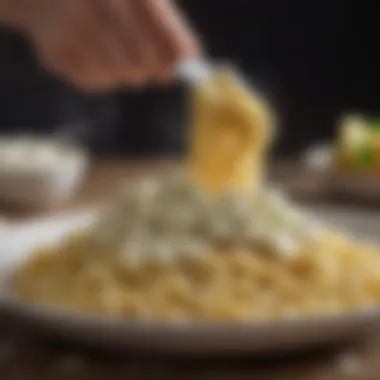The Ultimate Guide to Freezing Ricotta Cheese Efficiently


Intro
Freezing ricotta cheese is often overlooked in home cooking, yet it is a highly practical skill. Many cooks want the creamiest ricotta in their dishes, but they face a common hurdle: freshness. Freezing several portions can ensure a consistent supply and ultimately help avoid food waste. This guide not only delves into the freezing process but serves to clarify best practices in storage, thawing, texture retention, and creative uses in various recipes.
With this knowledge, both novice and experienced cooks will gain insightful techniques in gracefully navigating through challenges posed while managing ricotta. In this narrative, we will highlight each step and principle to make freezing ricotta a simple task and a rewarding endeavor in your culinary pursuits.
Recipe Overview
- Culinary Delight: Freezing Perfect Ricotta
- Portion Yield: Varies depending on storage method; typically 1 to 2 cups per batch.
- Prep Time: 10 minutes for initial prep, plus additional time for storage and thawing.
- Difficulty Level: Easy.
- Key Ingredients: Fresh ricotta cheese, airtight containers or freezer bags.
Step-by-Step Instructions
To ensure the ricotta maintains its flavor and texture during freezing, following precise steps is key.
- First, determine the amount of ricotta you wish to freeze. Generally, it's best to freeze in portion sizes that make cooking convenient in the future.
- Next, you need to prep the ricotta. Scoop it out and place it in a medium-sized bowl. Stir gently. Adding a bit of cream helps maintain moisture. This helps with texture after thawing. Let it sit at room temperature for about 5 to 10 minutes.
- Now, portion out the ricotta. Use freezer bags for single servings or small airtight containers for larger amounts. Squeeze out excess air from the bags before sealing to prevent freezer burn.
- Label each container or bag with the date before placing them in the freezer. This will help you track freshness later on.
Time-Saving Strategies
Instead of traditional airtight containers, freezer ice cube trays can be useful for small portions. Fill them with ricotta, cover with plastic wrap, and freeze. Once solid, transfer to a freezer bag. This alternative makes thawing and portion control easier.
Nutritional Information
Simply freezing ricotta preserves its essential qualities. On average, a 1/2 cup serving offers:
- Calories: 300 per serving.
- Macronutrient Breakdown: 12g of protein, 24g of fat, and 10g of carbohydrates per portion.
- Beneficial Nutrients: High in calcium, Vitamin A, and riboflavin, ricotta adds nutrition to your meals.
Quick Cooking Tips
To improve efficiency in the kitchen:
- Use tools such as food processors for blending ricotta with spices and herbs.
- Multitask by cooking pasta or sauces while thawing ricotta. This can enhance timing for full meal preparations.
- For a healthier twist, substitute ricotta with low-fat versions for dishes requiring cheese.
Related Recipes & Variations
Featuring ricotta opens multiple avenues for you. Consider a classic lasagna or creamy lasagna roll-up, both delicious options that can incorporate ricotta seamlessly. Further, those interested in gluten-free variations can research alternatives like almond flour noodles.
Experimenting with flavor can spark your creativity. Review ingredient combinations like almonds and herbs that work well with your frozen ricotta.
Above all, I encourage readers to share personal attempts and culinary adaptations they pursue, involving frozen ricotta in their home cooking journeys.
Foreword to Freezing Ricotta
Freezing ricotta is not just a practical decision, but a smart approach to managing kitchen resources. For individuals who appreciate the nuanced flavors of ricotta, its versatility offers value across numerous recipes. Understanding how to freeze ricotta properly can both save time in meal preparation and also reduce food waste.
Understanding Ricotta Cheese
Ricotta cheese is a soft, creamy cheese typically made from whey, a byproduct of cheese production. Its mild flavor and smooth texture make it suitable for various culinary uses, from lasagna to desserts. There are different types, such as whole milk ricotta and part-skim ricotta. Understanding the differences in fat content can inform both flavor and texture choices in recipes.
The production method adds an additional complexity. Ricotta is often fresh, meaning that its shelf life is limited. Without proper storage, it will spoil relatively quickly, leading to potential waste. When you freeze ricotta, the aim is to extend its use while maintaining its quality—allowing culinary enthusiasts access to this ingredient over an extended period. This provides an opportunity for less frequent grocery shopping.
Why Freeze Ricotta?
Freezing ricotta serves multiple purposes beyond simple preservation.
- Extending Shelf Life: By freezing this cheese, users significantly prolong its usability. Ricotta can often go from a few days to several months without losing its taste or quality, making it a wise choice for meal prepping.
- Cost Efficiency: Buying ricotta in bulk can lead to savings, and freezing mitigates the risk of spoilage. This is an important consideration for anyone managing their culinary budgeting.
- Meal Preparation Versatility: With frozen ricotta on hand, individuals can easily add it into various recipes, ranging from savory dishes, like stuffed shells, to sweet, rich desserts like cannoli. Flexibility becomes a strong point when planning meals.


Freezing ricotta enables enthusiasts to keep the ingredient accessible, ensuring its flavors and textures are ready when needed.
In summary, comprehending the basics of ricotta cheese and the rationale for freezing it is foundational in this exploration. Optimizing storage techniques empowers cooks to enhance their culinary experiences. Establishing knowledge on freezing ricotta offers a foothold for further discussions on preparation and methods of storage.
Preparation for Freezing
Freezing ricotta is more than just a convenient way to extend its shelf life. Preparation for freezing is crucial to retain the rich taste and creamy consistency of the cheese. Proper preparation involves several steps, ensuring that the ricotta maintains its qualities even after thawing. Appropriate handling before it is frozen can prevent texture issues, which can arise from inefficient freezing methods.
Selecting Quality Ricotta
Selecting quality ricotta is pivotal to the overall success of the freezing process. Fresh, high-quality ricotta has a delicate texture and flavor that can fade quickly if not handled properly. Choose ricotta that is creamy and smooth, free from off-odors or an overly watery texture. A good tip is to opt for local artisan cheese when possible, as they often produce ricotta using traditional methods, resulting in superior taste. Checking the expiration date on the packaging and ensuring it is well within that date is also important. Remember, better starting quality leads to better frozen results, which is essential for any culinary pursuit.
Portioning Out Ricotta
Portioning out ricotta is another key part of effective preparation. By dividing ricotta into portions prior to freezing, you can thaw and use only what you need, wasting nothing. This method is particularly helpful for those who use ricotta in various recipes, like lasagna or stuffed shells. Ideal portion sizes can depend on your needs — whether providing enough for a single serving or for larger dishes. Utilizing disposable containers or freezer bags allows for easy handling and avoids the awkwardness of trying to measure out frozen ricotta later.
Deciding Between Whole and Low-Fat Ricotta
When considering what type of ricotta to freeze, the choice between whole and low-fat ricotta warrants attention. Whole ricotta typically retains a creamier texture after freezing, making it preferable for recipes where creaminess is key. Low-fat ricotta, however, is easier to incorporate in certain dishes for those watching their calorie intake yet may yield worsening texture after being frozen. Before making a decision, consider what dish you intend to create post-thaw—some uses might favor one type over the other. Each option has benefits and drawbacks relative to your cooking goals. Moments spent contemplating this will enhance your final outcomes.
Remember: Proper selection, portioning, and type choice can make all the difference in preserving the delicacy of ricotta.*
Methods of Freezing Ricotta
Freezing ricotta cheese may seem like a straightforward task, but understanding the methods you can use is essential for preserving its quality. Various factors affect the freezing process and ultimatelly the texture and flavor of ricotta. Selecting the suitable method based on your specific needs will ensure that your frozen ricotta remains just as usable and delicious as fresh.
Freezing in Airtight Containers
Using airtight containers to freeze ricotta is one of the most reliable methods. First, it protects the ricotta from air exposure. Air is a leading cause of freezer burn, which can ruin the texture and flavor. When you choose this method, you should follow some important steps.
- Opt for rigid containers that can withstand the cold.
- Leave about half an inch of space at the top of the containder. This allows for expansion as the cheese freezes, preventing the container from breaking.
Another advantage of this method is that containers are easy to stack. This can help in maximizing your freezer space. Avoid using containers made of lightweight plastic; they might not hold up well in colder temperatures.
Using Freezer Bags
Freezer bags can be a perfect solution if you’re dealing with larger quantities of ricotta. They provide flexibility and ease of handling. To start with, portion out the ricotta into manageable amounts. Then, place each portion into a freezer bag.
- Press out as much air as possible before sealing to help reduce the chance of freezer burn.
- Label the bags with the freezer date. This alows you to keep track of how long the cheese has been stored.
The bags fit well in smaller gaps in the freezer, ecoording to some users, making it beneficial for efficient storage. Once you’re ready to use the ricotta, you can thaw only what you need.
Freezing Ricotta in Ice Cube Trays
Freezing ricotta in ice cube trays is an excellent method for those who like to use ricotta in small amounts. This technique also allows for easy portion control. Start by scooping your ricotta into each compartment of a clean ice cube tray.
- After filling the tray, cover it with plastic wrap. This limits air contact and guards against freezer burn.
- Once frozen solid, you can transfer the ricotta cubes into a labeled freezer bag for more extended storage.
This method greatly simplifyies measuring out small amounts for recipes like sauces or soups. Also, it make the ricotta quick to thaw. Just pull out a cube or two as needed, then let it thaw.
By understanding these various methods of freezing ricotta, you can keep your cooking endeavors tasty and efficient. Choose based on your kitchen habits and how you plan to use ricotta post-freeze.
Storage Guidelines
Storing ricotta properly is crucial to preserving its quality and integrity. When freezing, it is essential to consider various factors that affect the ricotta's overall flavor and texture after thawing. Observing specific storage guidelines ensures that you avoid common pitfalls and can enjoy the flavors of fresh ricotta even when it has been frozen for some time.


One significant element in ricotta storage is ensuring that the cheese remains as fresh as possible throughout its time in the freezer. Accurate storage methods can extend the desired shelf-life and provide optimal enjoyment when it is finally time to utilize the ricotta. Besides maintaining taste, how ricotta is stored through specific methods impacts its adaptability in cooking. Thus, couples of significant facts merit attention in this section we cover two major areas: optimal freezing duration and avoiding freezer burn.
Optimal Freezing Duration
The suggested timeframe for storing ricotta in the freezer typically extends up to six months. During this duration, the quality of ricotta remains predominantly intact. After freezing, its flavor and texture significantly deteriorate over an extended time. Thus, it is wise to consume the ricotta within the early weeks of freezing when possible for peak freshness.
Some indicators of effective ricotta storage include:
- Observe the date frozen on each container to track how long it has been in the freezer.
- Assuming one or two usages are common, plan to keep ricotta pieces clearly labeled. This avoids any guesswork when creative cooking ideas arise.
- Ensure stored ricotta maintains its cooling properties consistently. Frequent temperature fluctuations can affect overall quality.
By observing these factors, you can Maximize enjoyment of ricotta after it's been frozzed.
Avoiding Freezer Burn
Freezer burn is a common but preventable occurrence that can diminish ricotta's value. Characterized by dehydrated spots and irregular texture, it can lead to a less desirable culinary outcome. There are critical strategies to suppress this unwanted phenomenon.
To avoid freezer burn, consider the following approaches:
- Use Airtight Containers: Choose container made from durable plastic or glass that seals tightly. This defends against moisture loss.
- Press Out Air from Bags: If using bags for wrapper frozen items, squeeze air out as effective as possible. A vacuum sealer can also be a practical solution.
- Keep Freezer’s Temperature Stable: Ensure your freezer maintains an appropriate temperature. Most freezers are optimum at or below 0°F (-18°C).
- Wrap Separately When Necessary: When freezing ricotta in portions, limit exposure by using plastic wrap before placing in the container.
By integrating these preventive measures into your method of freezing ricotta, you enhance overall experience and retain excellent taste retention until its needed for application.
Proper storage methods are pivotal in enjoying ricotta at its best. Good practices reduce wasting time looking for alternatives. Choose right now to go forward will make culinary choices pleasing further down the road.
Thawing Frozen Ricotta
Thawing ricotta cheese properly is a crucial step that dictates its usability after freezing. If not handled with care, ricotta can lose its characteristic creamy texture. Understanding the correct methods for thawing can preserve both flavor and texture. This section dives into suitable thawing techniques and the inevitable impact on ricotta's quality post-thaw.
Safe Thawing Techniques
Thawing might seem straightforward, but it requires attention to detail. There are several techniques you can employ to do it properly. It's best to avoid rapid thawing in a microwave, as this can lead to inconsistent texture and even partial cooking, which is not suitable for cheese. The recommended methods are:
- Refrigerator Method: Place the frozen ricotta in the fridge. This may take several hours or overnight, but it ensures gentle defrosting.
- Cold Water Bath: For a quicker option, submerge the sealed container in cold water. This method typically takes one to two hours, depending on the size of your ricotta parcel.
- Direct Application: In certain recipes, it's acceptable to add frozen ricotta directly without thawing. This might work well for dishes cooked at high temperature like lasagna, just extend the cooking time slightly.
Whichever method you choose, ensure that the ricotta cheese remains sealed throughout the thawing process to prevent contamination from other odors or excess moisture.
Impact on Texture
One primary concern when thawing ricotta revolves around its texture. After freezing and thawing, ricotta often experiences slight changes compared to its original state. The cooling process can cause some separation of whey from the solid curds.
Most users find that with proper thawing methods, ricotta retains a pleasantly creamy consistency, though it may become slightly grainy. For many culinary applications, this texture can still be acceptable. However, be prepared for:
- Some Water Separation: If you notice small pools of water on the surface, just drain this off
- Texture Alteration: Will not hinder the quality when cooked in dishes
For those making spreads or ricotta pancakes, it may require additional whisking to achieve a desirable consistency. Keeping this texture alteration in mind equips you to successfully integrate thawed ricotta in various cooking scenarios.
Understanding these thawing techniques can substantially impact the success of your dish. Proper practices not only maintain integrity but also enhance texture ready for culinary creations.
Culinary Uses for Thawed Ricotta
The versatility of ricotta cheese makes it an excellent ingredient in various culinary applications. Once you have thawed your frozen ricotta, understanding its many uses becomes essential not only for maximizing its flavors but also for getting the most out of your kitchen endeavors. Utilizing thawed ricotta allows for a wider range of creative expressions in your cooking. It enables any culinary enthusiast to explore textures and tastes that can elevate a dish from ordinary to extraordinary.
In Salads and Dishes
Thawed ricotta can serve as a delightful addition to salads and various savory dishes. Its creamy texture complements vegetables well, and its subtle taste enhances the meal without overpowering other flavors. Consider these benefits when incorporating ricotta:


- Creaminess: When added to salads, ricotta introduces a creamy element that's lighter than dressing or mayonise.
- Nutritional Boost: Ricotta is rich in protein and calcium, adding healthy nutrients to salads inherently.
- Flavor Adaptability: It easily absorbs surrounding flavors, making it versatile.
For example, you might mix ricotta with fresh herbs like basil or chives to create a delicious spread for salads that goes wonderfully with peeled cherry tomatoes and some finely diced cucumbers.
Additionally, using ricotta as a base in light pasta dishes can also be effective. Thin it with a splash of olive oil or chicken broth to achieve the desired consistency for your pasta sauce, enhancing both flavor and creaminess.
In Baking Recipes
Ricotta finds unique applications in various baking recipes. It is often used to add moisture and texture to baked goods, creating a balance between other ingredients. Here are some notable uses:
- Ricotta Cheesecakes: Using thawed ricotta for cheesecake imparts a lightness, setting it apart from traditional cream cheese recipes. It gives dense cheesecakes a subtle richness while maintaining a fluffy texture.
- Pancakes and Waffles: Incorporating ricotta into your pancake or waffle batter can enhance the flavors and create an irresistibly fluffy texture that is pleasingly rich.
- Bread and Muffins: Adding ricotta into bread or muffin recipes produces results that are moist and tender. The cheese contributes both to the crumb structure and to taste.
To successfully employ ricotta in baking, it’s crucial to consider the recipe requirements, such as wet and dry ingredient ratios. Adjustments may be needed to ensure the contemplating output is ideal.
Remember: Once thawed, ricotta can hold moisture, impacting how you measure ingredients in your recipes.
In summary, thawed ricotta not only allows for delectable dinners or light lunches but thrives in dessert recipes too. Discovering culinary uses for ricotta broadens your cooking options and makes every meal more enjoyable, adding depth into your daily cooking experiments.
Common Mistakes to Avoid
When considering the process of freezing ricotta cheese, there are common mistakes that can hinder quality and taste. Addressing these errors is crucial for culinary enthusiasts wanting to optimize their cooking practices. Freezing ricotta should be a straightforward process, yet many overlook key steps that can alter the final outcome. Understanding these missteps can lead to a more satisfying culinary experience.
Freezing Process Errors
Errors in the freezing process can greatly affect the texture and flavor of ricotta. Here are some of the frequent mistakes:
- Not using the right containers: It's essential to use airtight containers or bags to protect the cheese during freezing. Using non-airtight packaging can lead to freezer burn, impacting flavor negatively.
- Skipping portioning: It is advisable to portion ricotta into smaller amounts before freezing. Larger blocks are harder to thaw and may become mushy upon extended freezing.
- Not draining excess liquid: If there is extra liquid in ricotta, it can expand during freezing and lead to textural changes. It's important to gently drain the icrease prior to freezing to maintain consistency.
Overall, being mindful of these freezing process errors ensures that ricotta remains fresh and usable when needed.
Usage After Thawing
Improper usage of ricotta after thawing can also go unnoticed until it's too late. Here are common misconceptions:
- Assuming all thawed ricotta can be treated the same way: Different techniques may be needed depending on how ricotta was frozen. For instance, ricotta frozen in smaller portions is generally easier to incorporate in recipes compared to large blocks.
- Neglecting texture changes: Thawed ricotta may have a different texture. Rather htan panicking, consider using it in dishes where texture is less noticeable, such as in sauces or mixed items rather than as a standalone or topping.
- Throwing away leftovers: Many people toss out thawed ricotta that they do not use at once. It can often be refrigerated for a short while. Always check for any signs of spoilage before discarding.
By being aware of these usage errors, you can maximize the utilization of thawed ricotta, minimizing waste while enhancing your dishes.
Avoiding these common mistakes will ensure that your ricotta remains delicious and serves your cooking needs effectively.
Ending
The conclusion section is critical for synthesizing the information presented in this article. It serves as a final summation of the various techniques and practical tips shared for freezing ricotta. A comprehensive overview clarifies any lingering uncertainties about the freezing process, ensuring that readers finish with a clear understanding of how to preserve this versatile cheese effectively.
Summarizing key points reinforces the benefits that freezing ricotta provides. Readers will find the importance of selecting quality ricotta, utilizing proper storage methods, and mastering thawing techniques indispensable. Not only do these steps help maintain the cheese's flavor and texture, but they also ensure that culinary applications can be fully enjoyed without compromise.
Another important aspect addressed in the conclusion is the craftsmanship involved in cooking with thawed ricotta. Encouraging readers to explore different charging aspect like baking or enhancing dishes further enriches the culinary experience. This sets a pathway towards culinary exploration that fosters creativity and curiosity among cooks.
Summary of Key Points
- Freezing Ricotta: essential techniques for preserving its quality.
- Storage Methods: consider airtight containers, freezer bags, or ice cube trays based on serving size
- Thawing Processes: safe and effective methods protect cheese integrity.
- Culinary Uses: simple integration into both concise recipes or elaborate meals can enhance flavors.
In essence, adhering to these suggestions not only improves the practical aspects of managing ricotta but also opens doors to new culinary experiences.
Encouragement for Culinary Exploration
As you grasp the nuances of freezing and thawing ricotta, think of how this opens an expanded realm of culinary possibilities. Studies show a desire to delve into cooking increases with the discovery of new techniques. Embrace the experimentation aspect; incorporate it into your everyday cooking rituals.
Using thawed ricotta brings texture and richness, transforming simple salads or native baked goods into something special. Perhaps experiment adding herbs, spices or even fruits in composing receipts. Each weighted addition on ricotta pulls forth a different signature note of flavor.
Your knock-on door awaits creativity. So experiment with flavors by incorporating ricotta into savory pasta dishes or desserts like cannolis and cheesecake. The options become limited only by whatevr your taste buds dictate.
The culinary journey does not stop here; it extends further as you learn to pivot between traditional and adventurous recipes. By embracing the act of cooking and preserving ricotta, you enhance your culinary abilities while maximizing the flavors your dishes can offer. The joy that comes from exploring flavours is tantamount to the satisfaction gained through acquiring skills. Collaborate with fellow food enthusiasts on platforms like reddit.com so you can share inspirations and learn from each other.







